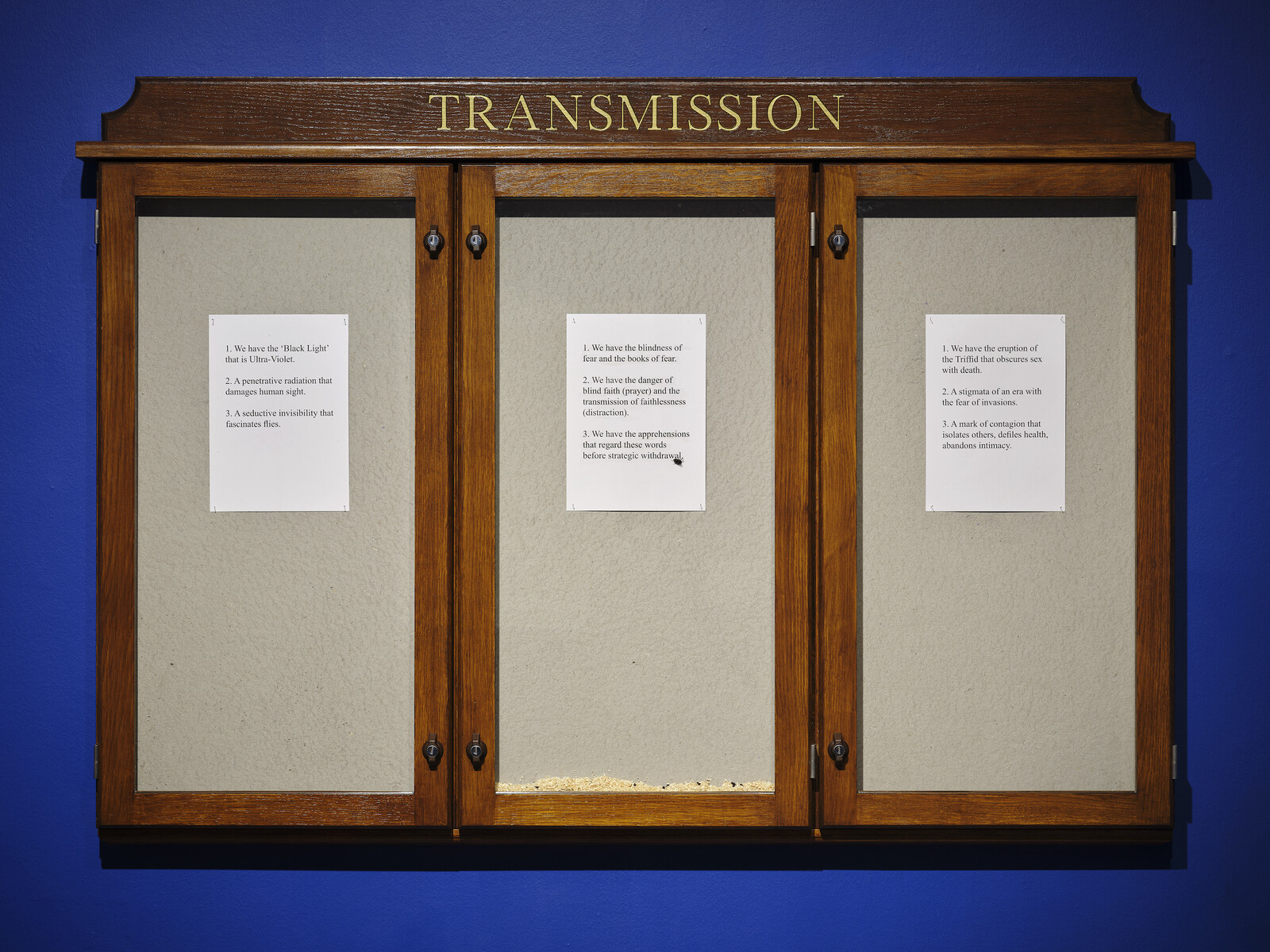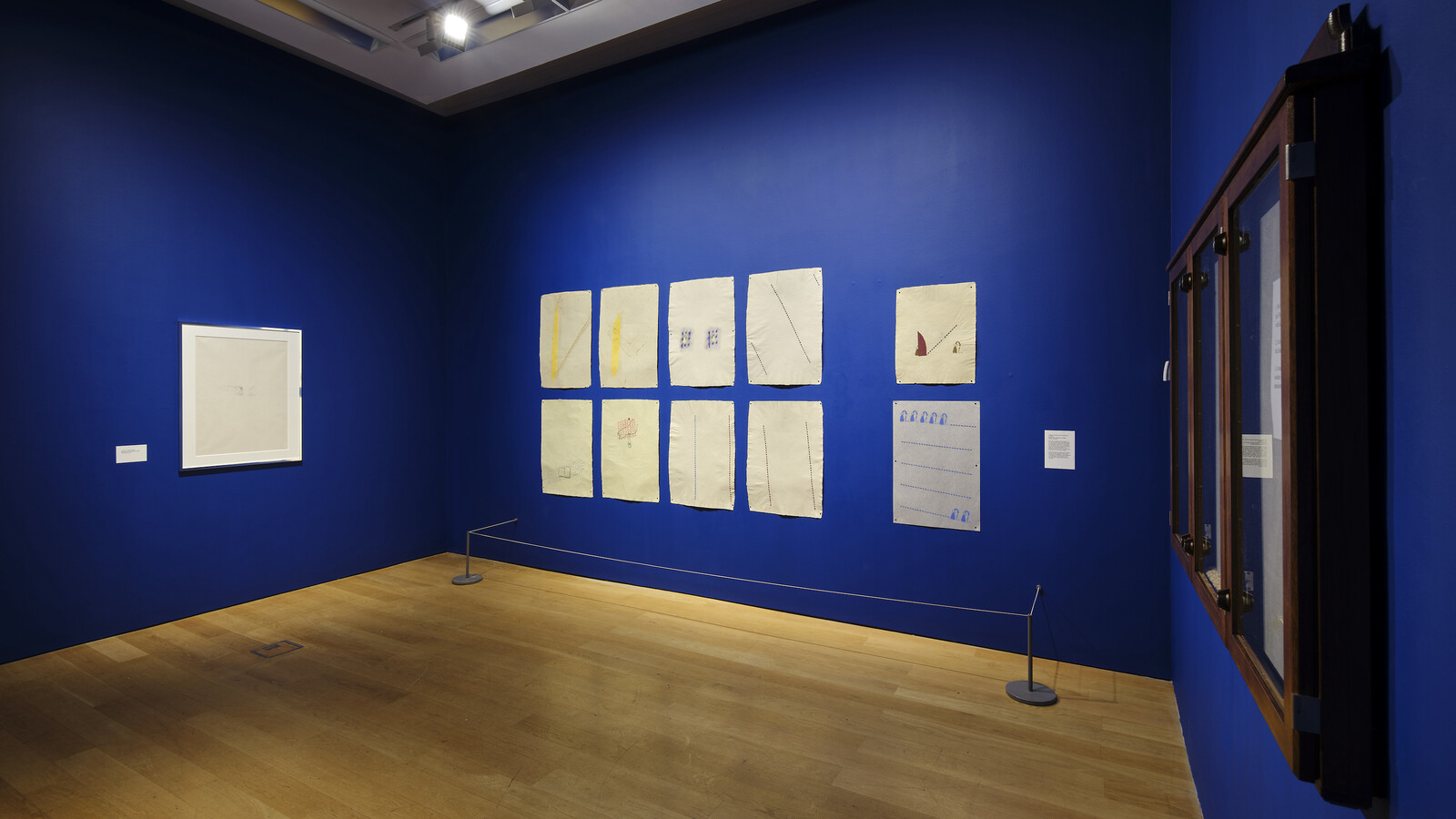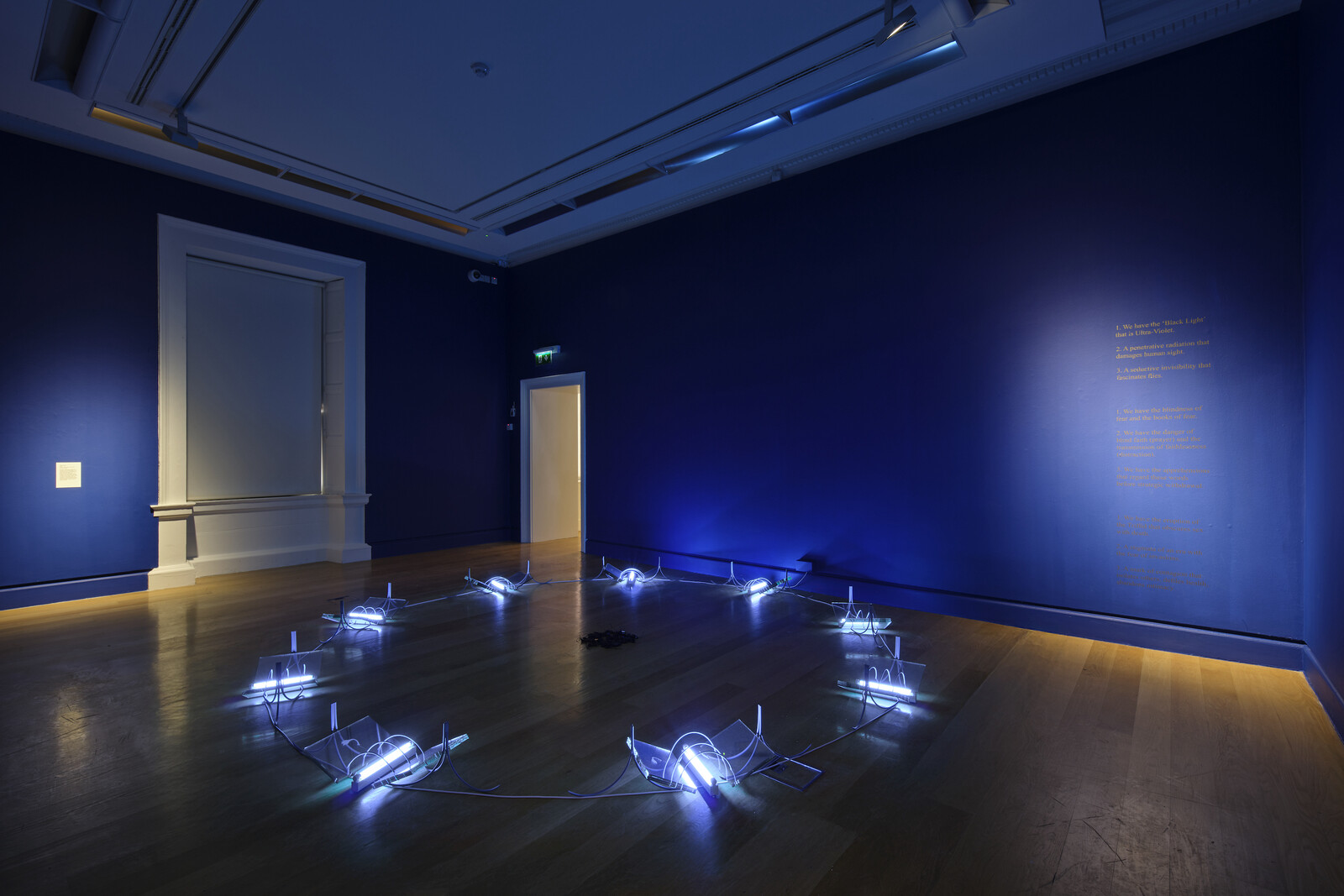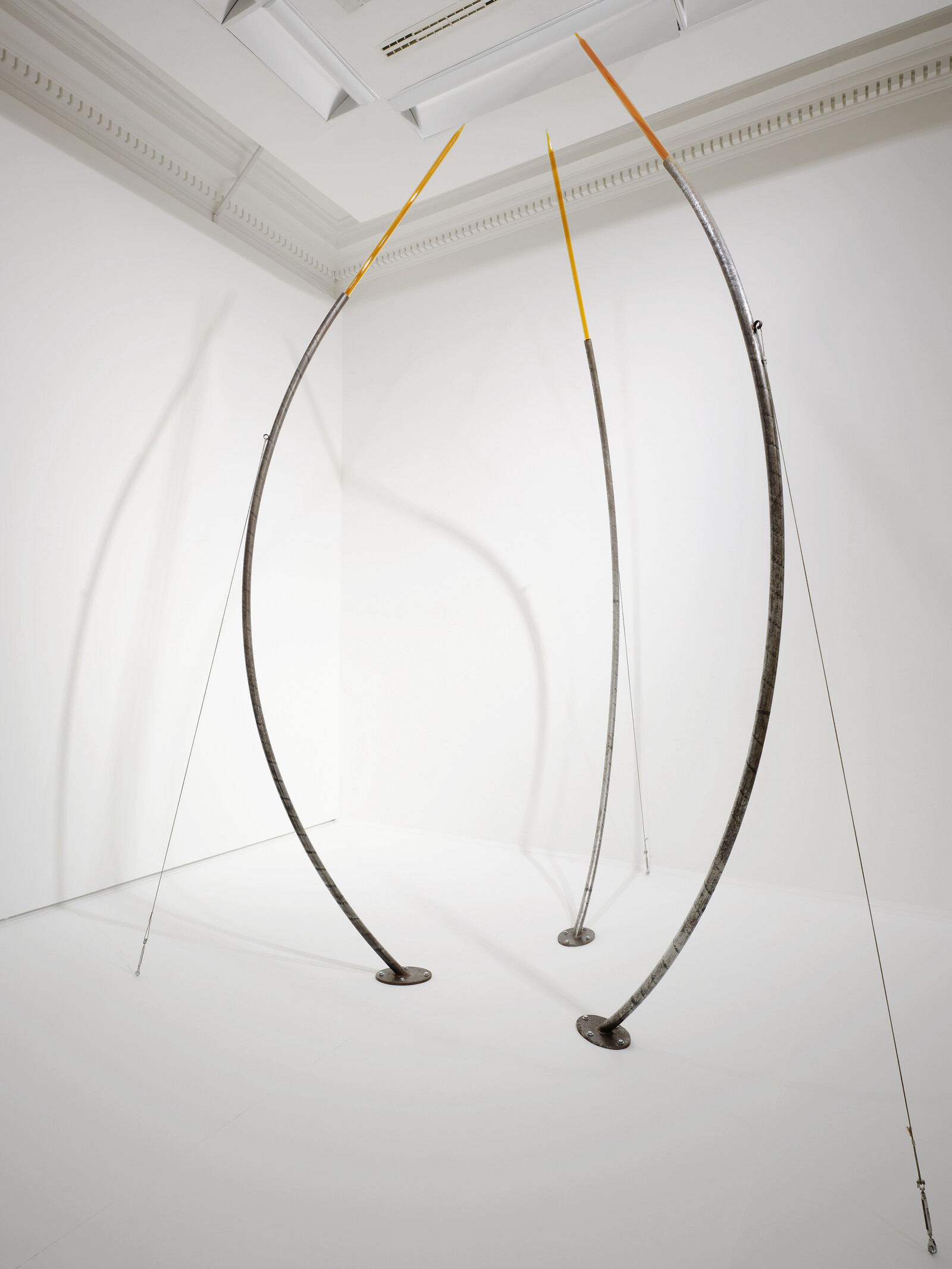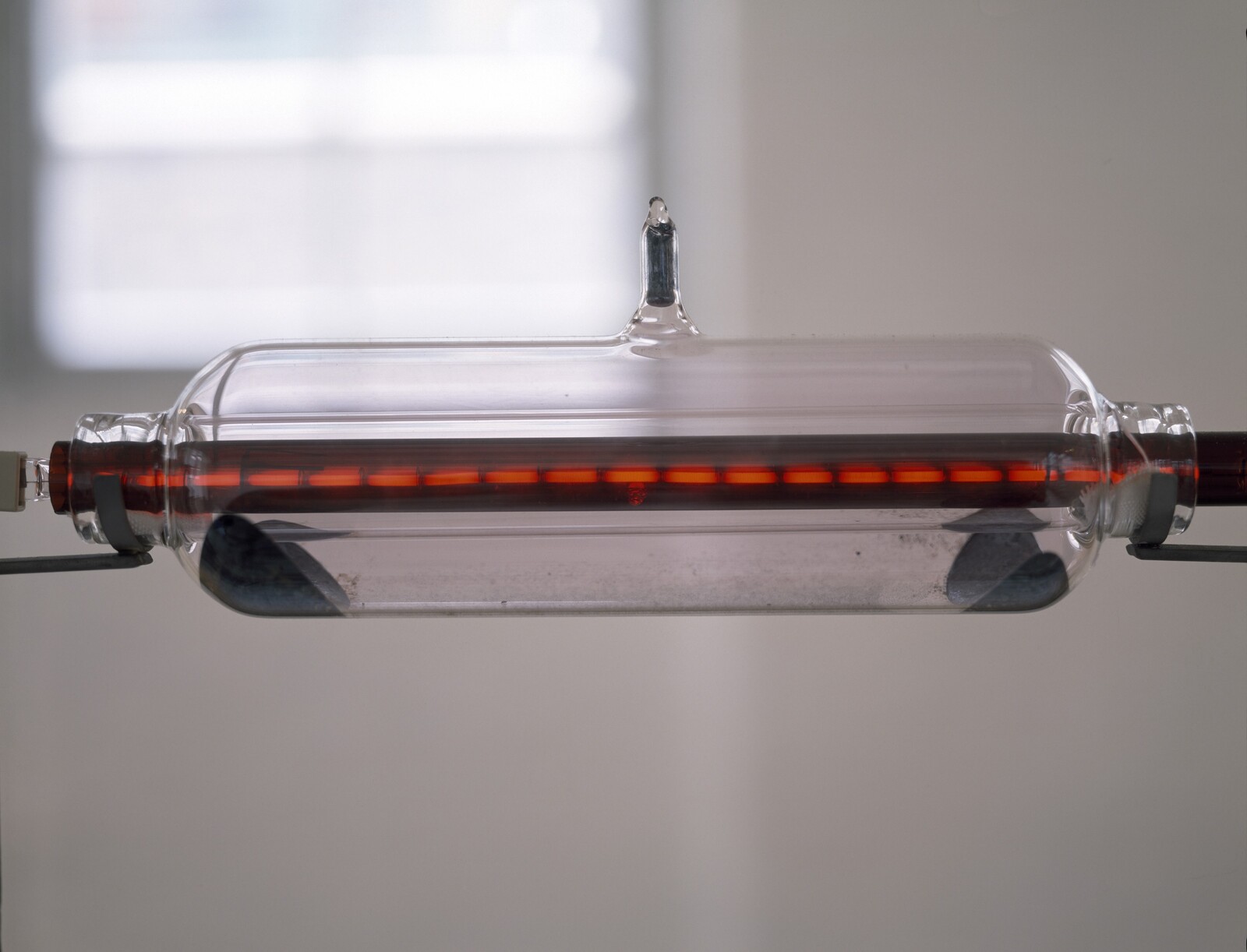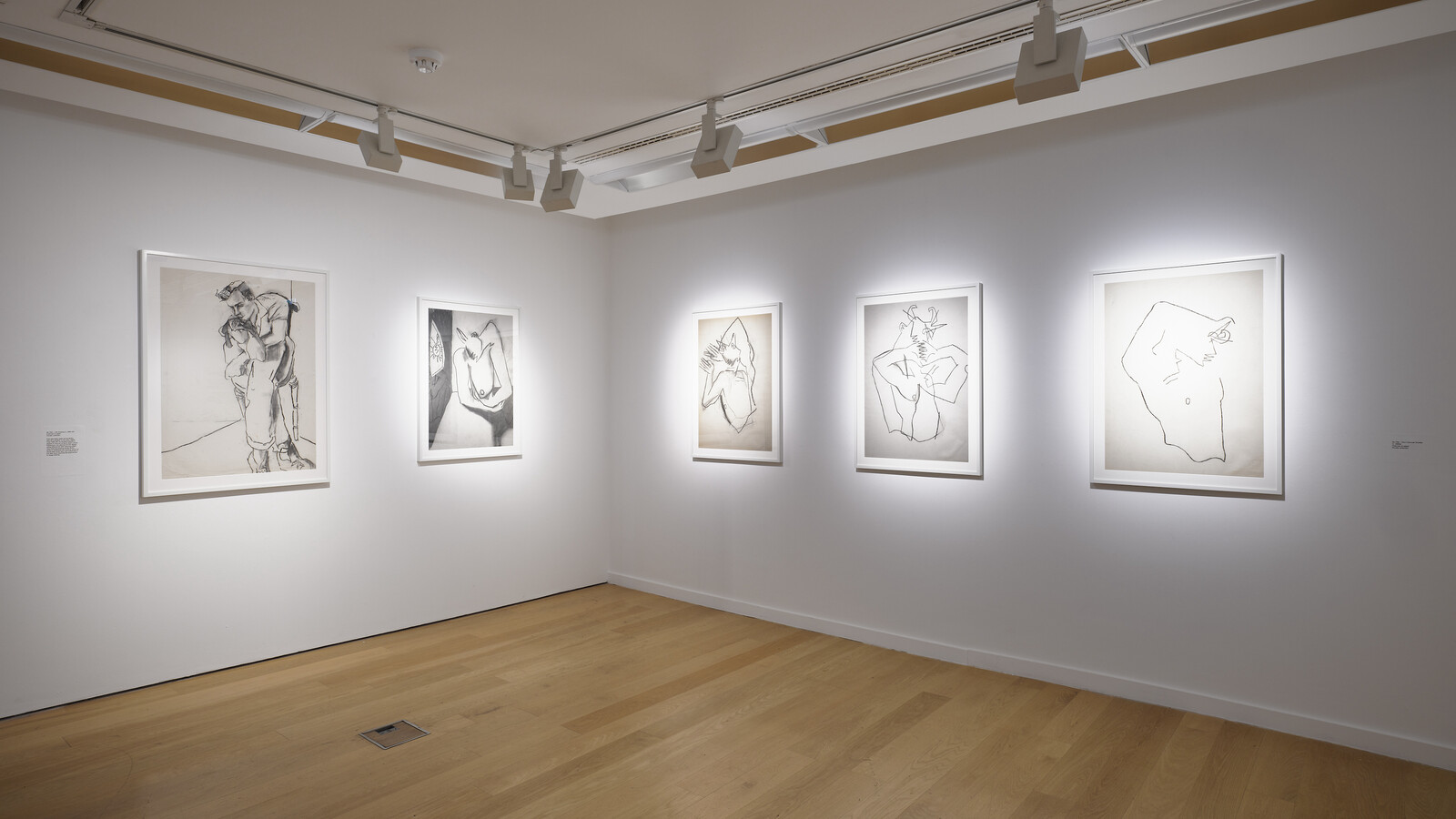Hamad Butt’s long overdue first retrospective opens with what might as well be a statement of unfinished business. A noticeboard headered with the word “TRANSMISSION” houses behind its glass doors a colony of live flies; pinned to the board are three sheets of A4 paper printed with tercets canticulating blindness, fear, contagion, and the obscuration of sex with death. Transmission (1990)—a chilling installation revolving a prayer circle of glass books splayed on the floor on parabolic legs, with the pages resembling wings, and the potentially blinding ultraviolet lights acting as spines, or thoraxes—is Butt’s first concrete response to the AIDS crisis, spurred by his own HIV-positive diagnosis in 1987, the same year he enrolled, aged twenty-five, at Goldsmith’s College in London. It was the focus of his degree show in June 1990, a month before the former Goldsmith’s student Damien Hirst exhibited his raucously acclaimed, also fly-infested A Thousand Years (1990). Presumably interpreting Hirst’s piece as plagiarism, Butt revoked the flies from his own installation and the original noticeboard has long been lost. Although the wall text omits this controversy, the curators have honored the artist’s decision by showing the refabricated component separately, presenting the rest of the installation in the following room with Butt’s text printed on the wall.1
Rather than attempt a linear survey of a career that was truncated almost as it took wing—Butt died at the age of 32 in 1994—the show leads with his two groundbreaking installations of the early 1990s before offering a chronologically broader presentation of his paintings and graphic works on a separate floor. The refabrication of the fly-infested noticeboard—an early example of art incorporating a kind of biotechnology—resuscitates a matter crucial to Butt’s political relevance. The artist’s solemn and oblique response to mass death did not fit in with the fairground kitsch of Hirst, Marc Quinn, or Jake and Dinos Chapman, whose work distanced us from mortality by casting it as a cheap “sensationalist” thrill—an effective death denial that presaged the false optimism of “Cool Britannia.” “1. We have the blindness of fear and the books of fear. 2. We have the danger of blind faith (prayer) and the transmission of faithlessness (distraction),” Transmission’s text reads, meaning folding in on itself as it hints at society’s blindness: its neglect of victims of a disease deemed only to affect maligned social groups, not to mention the persistent psychosis of HIV/AIDS denialism.2 Butt’s indeterminacy of language elicits fear by withholding any easy interpretation. That fear hinges on the arresting refrain “we have”: we are all accountable to each other.
After Transmission, Butt would live only to make one more installation. “Familiars” (1992) is a three-part series, here presented across two rooms, each part featuring a noxious chemical sealed in a glass container, whose form imaginarily anticipates its breakage—an allusion to “the threat of contamination associated with AIDS,” the wall text explains. Familiars 1: Substance Sublimation Unit is a glass ladder, each rung filled with iodine crystals that sublimate when heated, one at a time, in an ascending sequence, while Familiars 3: Cradle consists of a “Newton’s cradle” of glass spheres filled with chlorine. On one level, the invitation to interact with the works—a metonym of sexual desire—potentializes calamity. Yet Butt’s great achievement here is to sustain amid crisis an emotional register of contemplation—in the stillness of Cradle, in the slow escalation of the ladder, quiet austerity far-removed from the sensationalism of some of his more famous young British contemporaries—that suspends us between the diverse meanings of “apprehension,” denoting understanding, arrest, and fear.3
Familiars 2: Hypostasis is made of three convex spikes spanning the height of the room, mostly made of steel, tipped with sealed nibs of liquid bromine, as if red hot, penetrating a heavenly realm—which could also be hell, considering the caustic, carcinogenic substance within the glass. Hypostases are the three theological components of the Godhead, the phallic connotations of which were not lost on Christian mystics, who frequently incorporated carnal imagery in their descriptions of divine love (it’s unlikely they would have been lost on Butt, given his breadth of esoteric knowledge), here conjured by the triad’s upward thrust.4 Butt expressed an interest in alchemy and hermeticism—which both relate to mysticism—and well as the ascetic rise of the soul advocated by the theologian John Climacus. 5 Understood in this oblique, mystical-contemplative light, Cradle becomes testicular; the ladder invokes the psychoanalytical concept of sublimation as the translation of sexual desire—and yet there is something so cruel and punishing about the need to sublimate sex. Herein lies one of the most painful tragedies of AIDS: that erotic love, potentially uplifting for the soul, should be lethal for the body.
Butt’s paintings and graphic works—exhibited here with his installations for the first time—reveal an artist always concerned with the fraught entanglement of love and death. In the earlier, pre-1987 works, the symbolism is literal. In the painting No title—Bathing Figure (ca. 1985–86), a male nude ascends through a towel, stamping down on a former, grey and putrescent self. The sentiment evoked in Butt’s iconography could accord with Douglas Crimp’s advocacy of shame as an “affective substrate necessary to the transformation of one’s distinctiveness into a queer kind of dignity.”6 The drawings made post-diagnosis and contemporaneous with his time at Goldsmith’s embody the liminality of his installations. They depict men, their eyes closed, inwardly experiencing the linear, chromatic, emblematic, and dangerous energies around them. The figures could be him, or us—apprehending.
In the work’s first exhibition after the degree show, at Milch Gallery, London, in 1990, the text was sandblasted on the windows.
One only need to think of Donald Trump’s presumptive election of Robert F. Kennedy Jr., who denies that HIV causes AIDS, to the office of US Secretary of Health to apprehend the endurance of such conspiracy.
Butt ruminated on this word in his undergraduate thesis (1990), which lends its title to the exhibition; see Hamad Butt, “Apprehensions,” in Apprehensions, ed. Dominic Johnson (Munich, London, and New York: Prestel Verlag, 2025), 153.
Simon Critchley, On Mysticism: The Experience of Mysticism (London: Profile, 2024), 20–21, 81–86.
See Hamad Butt, “Indications,” in Johnson, Apprehensions, 171–173.
Douglas Crimp, “Mario Montez, For Shame,” in Regarding Sedgwick: Essays on Queer Culture and Critical Theory, eds. Stephen M. Barber and David L. Clark (New York: Routledge, 2002), 66–67.
